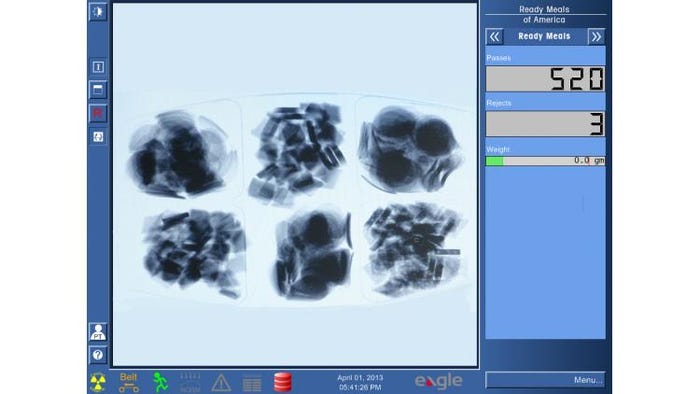How to choose between single- or dual-energy x-ray systems
March 15, 2017
Food manufacturers across the globe have been relying on x-ray technology since the early 1990s to protect consumers, reduce the risk of product recalls and safeguard their brands.
Two types of x-ray technology are used for food inspection today—single energy and dual energy. Some food processors believe that, irrespective of the application, dual energy is always best. However, this is not always the case. It is a myth that, regardless of the application, dual energy automatically provides better sensitivity.
The right choice of technology depends on five factors:
1. The likely contaminants a manufacturer will encounter;
2. The product;
3. The type of packaging;
4. Production speed; and
5. Customer specifications.
How they work
In simple terms, an x-ray system uses an x-ray generator to project a beam of low energy x-rays onto a sensor or detector. X-ray inspection involves passing a product or pack through the x-ray beam before it reaches the detector. The amount of x-ray energy absorbed during the beam’s passage through a product is affected by the product’s thickness, density and atomic number.
When the product passes through the x-ray beam, only the residual energy reaches the detector and measurement of the difference in absorption between the product and a foreign body is the basis of foreign body detection in x-ray inspection.
An x-ray system is essentially a scanning device. When a product passes through the system at a constant speed, the x-ray detector captures a “greyscale” image of the product (see image below). This is generated by measuring the amount of x-ray energy reaching the detector. Each image is made up of pixels and the x-ray energy absorbed by each pixel creates a value on a greyscale (from black 0 to white 65,535). As the product or pack passes over the detector, each line of grey level data is added to previous lines, much like slices of bread can be added to form a loaf, resulting in a complete product image. Software within the x-ray system analyzes the image and compares it to a pre-determined acceptance standard.

On the basis of this comparison, the system either accepts or rejects the image (and the product/pack it represents). In the case of rejection, software sends a signal to an automatic reject system, which then removes the product from the production line.
Like conventional single-energy x-ray inspection technology described above, dual-energy technology involves using a generator to project an x-ray beam onto a detector and passing a product through the beam. However, dual energy diverges from single-energy x-ray inspection as it uses two energy spectrums to discriminate between high and low channel x-rays, as well as a dual-layer detector. While the top detector is sensitive to lower energy (longer wavelength x-rays), the bottom detector is sensitive to higher energy (shorter wavelength x-rays). The two detectors are separated by a small copper plate that filters out the low-energy x-ray and only allows the high-energy x-ray to pass through to the high energy detector.
When an x-ray beam is projected through a product, some of the energies will be absorbed, while others will pass through. What gets absorbed and what passes through depends on the product’s composition.
Materials are made up of elements and each element has its own atomic number. For a given x-ray energy, as the atomic number increases, the element absorbs more x-ray energy and passes less. So carbon, with an atomic number of 6, absorbs much less x-ray energy than lead, with an atomic number of 82. Lead absorbs almost all x-ray energies, which is why it is commonly used as shielding in places like medical x-ray labs.
As elements have different atomic numbers, it is possible to measure differences in absorbance based on the elements in a material. The amount of x-ray absorbance a given element has depends on the x-ray energy, and as dual-energy x-ray systems have a detector array that gives values at two different energies—high and low—it is convenient to express these as a ratio.
Two separate images are generated by the two spectra of energy and a relative ratio of energy absorbed can be calculated to determine a material’s composition. So, in effect, dual-energy x-ray systems measure the ratio of two different sets of x-ray energies that pass through a product and this measurement enables organic and inorganic materials to be differentiated. Foreign body detection using dual-energy x-ray technology is therefore based on chemical composition (atomic number) rather than just density variation like single-energy x-ray technology.
Which technology is best for your application?
Single-energy x-ray inspection technology used to inspect food products for contamination is effective at detecting foreign bodies that exhibit an x-ray absorption spike relative to the surrounding product’s absorption. Such systems give food manufacturers exceptional levels of detection for stainless steel, ferrous and non-ferrous metals. They are also extremely good at detecting glass, calcified bone, mineral stone and high-density plastics and rubber, regardless of their shape, size or location within a product.
However, single-energy x-ray inspection technology is incapable of detecting thin glass, stones, rocks and low-density plastics and rubber in most food-based products.
Dual-energy technology is better at detecting objects that show a small x-ray absorption variation. This means that dense foreign bodies in dense products are more easily detected using dual-energy technology compared with single energy. For example, dual energy makes it possible to detect flat glass and stone in mixed nuts, both of which can be challenging to detect using single-energy detectors.
Dual-energy technology essentially removes most of the effect of product thickness variations and leaves an image that shows density difference based on chemical composition (atomic number). Food products are typically organic in composition and, if solid or liquid, contain water. Chemically, food products consist primarily of hydrogen, carbon and oxygen. Any foreign body containing an element of a higher atomic number than carbon or oxygen becomes more easily detectable using dual-energy technology.
Single-energy technology typically finds foreign bodies that are visible in an x-ray image, but many foreign bodies that are not readily visible in an x-ray image may be detected using dual-energy technology. For example, dual energy brings a distinct advantage when detecting inorganic foreign bodies such as flat glass (as opposed to cylindrical glass), bone, stones, rocks and low-density rubber and some plastics. Plastics and rubber that have inorganic filler or have a component of chlorine, bromine or fluorine also fall into this category.
Dual-energy x-ray technology shares some similarities with single-energy x-ray technology, but also diverges. Dual energy’s ability to discriminate materials by their chemical composition enables the detection of historically undetectable inorganic foreign bodies, and also enables food manufacturers to inspect products with complex density levels and in innovative pack styles.
However, as we have mentioned, dual-energy x-ray systems are not suitable for all food applications. There are some instances where dual energy will be best and many others where single energy will provide a better solution. The right choice of x-ray energy depends on five factors outlined earlier in this article: the likely contaminants, product, packaging, production speed and customer specification.
One thing is for sure: There is not usually an overlap regarding the selection of single-energy or dual-energy x-ray technology. Each application should be independently evaluated and food manufacturers should seek the advice of a reputable x-ray system supplier before making a decision.

As marketing manager at Eagle Product Inspection, author Christy Draus manages all areas of the marketing program and initiatives to drive strategy and business development across North America, Latin America, Europe, the Middle East, South Africa and Asia Pacific. With more than 13 years of experience, she successfully manages implementation of projects that support strategic marketing initiatives. Her diversified skill set in business-to-business environments includes product launches, brand management, lead generation and sales support. Draus holds a Bachelor of Science in Marketing from the University of South Florida.
About the Author(s)
You May Also Like


